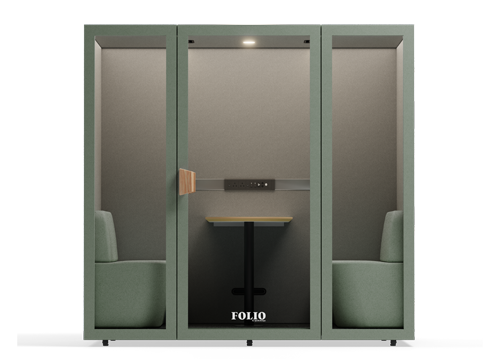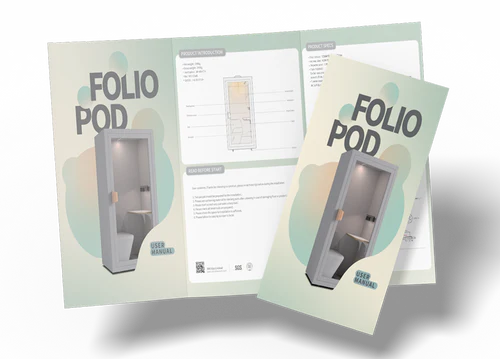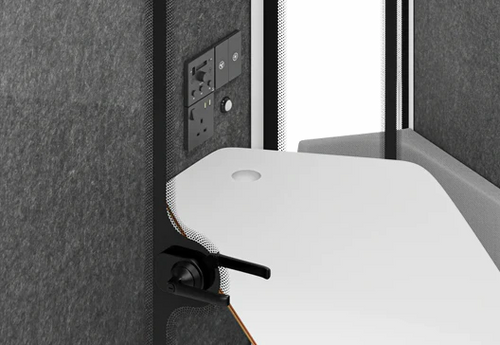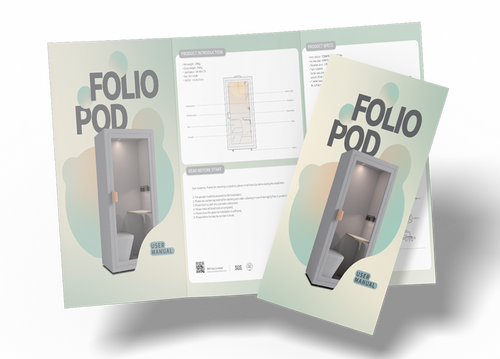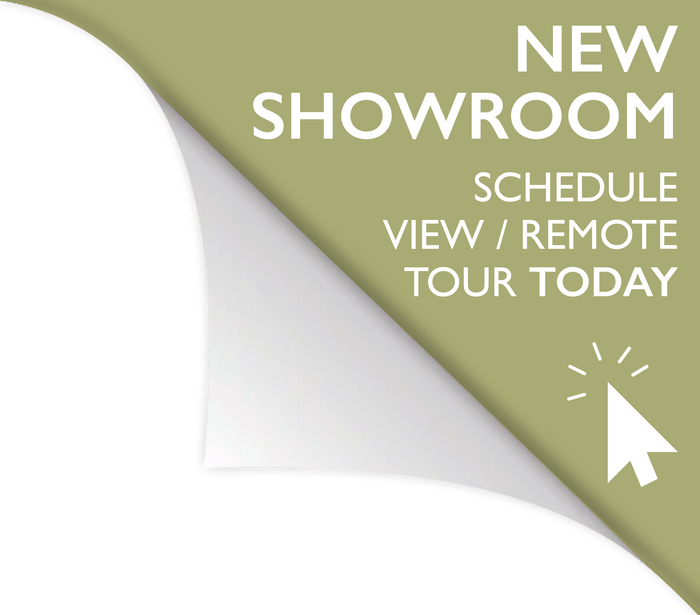How to Design a Focus Zone in a Busy Office
Create calm in the chaos with acoustic seating, clever screens, and lighting that knows when to take the hint.
You know the feeling — you’re trying to get your head down, but someone nearby’s on their third Teams call of the morning, someone else is rustling snacks like they’re auditioning for the Royal Philharmonic, and your desk light’s about as helpful as a chocolate teapot. Welcome to the joys of the busy office.
Now don’t get me wrong — energy in a workplace is no bad thing. A bit of chatter, a splash of collaboration, that’s the good stuff. But there comes a point where it all starts to boil over, and suddenly trying to focus feels like swimming upstream. That’s where a well-designed focus zone comes in. Not a full-on retreat from the world — just a pocket of calm where your brain can breathe.
And the beauty of it? You don’t need to knock walls down or reinvent your layout. With a few smart moves — like adding acoustic chairs, positioning a privacy screen, or getting your lighting setup just right — you can transform even the noisiest corner into a haven of productivity. It’s not about silence; it’s about signal control — helping your brain tune in and shut out the static.
One company we know (an architecture firm, no less) set up what they called their “focus nook” — just two high-backed seats, a screen, and a dimmable lamp. Nothing fancy, but within days, it became the go-to spot for sketching, writing, and the occasional “please-don’t-disturb” coffee break. It wasn’t about isolation — it was about intention. A space that said, “this is where the real thinking gets done.”
Because let’s face it — no one’s doing their best work half-distracted and lit like they’re in a dentist’s waiting room. If you want to help people hit their stride, you’ve got to give them the right setup. And that’s exactly what we’re diving into next: how to design a focus zone that cuts through the chaos without cutting you off from the rest of the team.
Why Focus Zones Matter (and What They’re Not)
Let’s clear something up from the off: a focus zone isn’t just a spare meeting room with a “Do Not Disturb” sign slapped on the door. And it’s not a makeshift desk tucked behind the printer where no one dares go. It’s a deliberately designed part of the office where people can do deep, uninterrupted work — without having to disappear completely from the team.

Because here’s the thing — most modern offices are built around collaboration. And that’s great, up to a point. But without a dedicated space for thinking, writing, planning, or just having a moment to reset, things get loud, scattered, and frankly exhausting. You wouldn’t expect a chef to plate up in the middle of a food court, so why do we expect focused work in full-blown open plan?
The rise in hybrid working hasn’t helped either. People are coming into the office for a reason — often to do the bits they can’t do at home. And yet, when they arrive, they’re faced with distraction central. That’s where a smart focus zone flips the script. It says: here’s your space. No background noise, no awkward interruptions, just a setup that lets you crack on.
From a business point of view, it’s a no-brainer. A well-placed focus area increases productivity, reduces the daily mental load, and gives employees more control over how they work. It also shows you care — about their time, their energy, and their ability to do good work without being pulled in ten different directions.
So no, focus zones aren’t about isolating people. They’re about enabling better work. And in the next section, we’ll walk you through what makes them tick — and how to get it right without turning your office into a library.
The Key Ingredients of an Effective Focus Zone
Creating a great focus zone doesn’t mean overhauling your office or splashing out on a full redesign. It’s about understanding what actually helps people settle in, cut the noise, and get on with their day. Think of it like building the ideal reading corner — only for deep work, not novels.
First off: acoustic furniture. High-back chairs, cushioned booths, or modular seating with sound-absorbing panels — these bits do the heavy lifting when it comes to dampening sound without boxing people in. They're comfy, subtle, and perfect for giving someone that “I’m getting things done” feeling without needing four walls.
Next up, privacy screens. Now we’re not talking about those tatty folding dividers from the ‘90s. Modern acoustic screens are sleek, mobile, and don’t make the space feel closed off. They’re brilliant for creating visual boundaries and muffling distractions — especially in open-plan layouts where everyone’s line of sight is everyone else’s business.
Let’s not forget lighting. It’s one of the most overlooked aspects of workspace design, yet it has a huge impact on focus and mood. Harsh overhead lights can feel clinical, while dim or inconsistent lighting just strains the eyes. What you want is layered lighting — a mix of ambient and task lighting that adapts throughout the day. Lamps with warm tones, dimmable settings, and a bit of directional control can make all the difference.
And then there’s layout. A true focus zone isn’t shoved in the corner like an afterthought. It needs to be accessible — close enough to stay connected, but far enough to avoid the constant hum of conversations and kettle chatter. Bonus points if it’s near natural light or greenery — anything that helps people feel calm and grounded.
Get these elements right, and what you’ve got isn’t just another seat — it’s a signal to your team: “We’ve thought about how you work best — and we’ve made space for it.”
Common Mistakes to Avoid When Creating Focus Zones

Designing a focus zone might sound easy — pop in a comfy chair, stick up a screen, and off you go, right? Not quite. There are a few classic errors that can turn your peaceful haven into a ghost town no one actually uses.
Mistake 1: Plonking it in a high-traffic area
That empty nook by the kettle or next to the printer might seem like a winner, but if it’s a shortcut to the biscuits or bang in the middle of team chatter, it won’t do much for focus. A focus zone needs to feel tucked away — not in the middle of the noise parade.
Mistake 2: Forgetting about sound
It’s not just about sightlines — if it’s still noisy, no one’s sticking around. A well-placed screen or high-back chair helps, but proper acoustic thinking matters too. In fact, research from Yarooms highlights that providing dedicated, sound-conscious spaces for quiet work significantly boosts employee performance and reduces cognitive fatigue. In short? Don’t just block the view — block the buzz.
Mistake 3: Poor lighting choices
Too bright, and you’re squinting. Too dim, and you’re halfway to a nap. Focus zones need lighting that supports concentration — not a migraine. Task lamps with warm tones and dimmable options are a solid investment.
Mistake 4: No one knows what it’s for
If there’s no signage, no policy, and no cultural nudge, your focus zone could end up being used for team lunches or impromptu catch-ups. Make it clear — visually and verbally — that this space is for quiet, intentional work.
Mistake 5: Overdesigning the thing
Some focus spaces end up looking more like designer showrooms than usable zones. Keep it simple. Clean lines, minimal clutter, and a layout that helps people breathe — that’s the sweet spot.
Nail the basics, and you’ll give your team a proper place to concentrate, decompress, and do their best work — without needing to escape to the stairwell.
Tips for Setting Up Your Own Focus Zone
So, you’re convinced a focus zone is the missing piece in your workplace puzzle. But where do you actually start? Thankfully, you don’t need an interior design degree or a massive refurb budget. Just a bit of planning, the right tools, and an understanding of what actually helps people think straight.
1. Pick the right spot
Location is everything. Look for a quieter corner of the office — away from high foot traffic, buzzing printers, and communal areas. If you’ve got natural light nearby, even better. People naturally gravitate to calm, sunlit spaces when they need to clear their heads.
2. Think acoustics before aesthetics
While it’s tempting to focus on how things look, it’s how they sound that makes or breaks a focus zone. Use soft materials where possible — rugs, upholstered seating, or acoustic panels — anything that’ll help absorb sound and reduce the echo chamber effect.
3. Keep it comfy but intentional
This isn’t a breakout lounge or a nap pod. Use acoustic chairs that encourage alertness but still provide support. Avoid overly casual furniture that invites slouching or long idle chats. It’s a space to get into the zone — not zone out.
4. Light the way to clarity
Layered lighting works best. Combine ambient lighting with task lighting so people can adapt the space to their needs. Avoid anything too clinical or fluorescent — warm-toned, indirect light goes a long way in keeping brains ticking without the squint.
5. Signal the purpose
Make it crystal clear what the space is for. That could be subtle signage, a simple name (e.g. “Focus Corner”), or even a soft spoken cue as part of your office culture. When people know it’s a place for head-down time, they’ll respect it more — and use it better.
6. Make it flexible, not fussy
The beauty of a modern focus zone is that it doesn’t have to be permanent. Use mobile screens or modular seating so you can adapt it as your team or space grows. Flexibility is your friend — it keeps things fresh and future-proof.
When all’s said and done, a focus zone isn’t just about aesthetics — it’s about intent. It shows your team that their time, energy, and attention matter. And trust us — they’ll thank you for it.
Why Focus Zones Are More Than a Design Trend
Let’s be honest — the phrase “quiet zone” might once have conjured up images of a dusty library corner or some awkward cubicle no one really used. But that’s no longer the case. In today’s world of overstimulation, constant pings, and shrinking attention spans, a well-designed focus zone isn’t just a nice-to-have — it’s a necessity.
This isn’t about jumping on some fleeting office trend to keep up with the neighbours. It’s about recognising that in a workplace built for noise and collaboration, people still need somewhere to retreat — to breathe, think, and get stuck into meaningful work. And when businesses give their teams that kind of space, the benefits ripple out. Sharper thinking. Fewer mistakes. Less burnout. Happier staff.
What’s more, adding a focus zone doesn’t require knocking through walls or ordering an entire new furniture suite. With a bit of thought around layout, acoustics, lighting, and purpose, you can create something that quietly transforms the way people experience their day — and delivers results you can actually measure.
So if your current setup leaves your team frazzled before lunch, maybe it’s time to rethink how your office supports focus. Because in the end, productivity isn’t just about the tools people use — it’s about the environment they’re working in.


